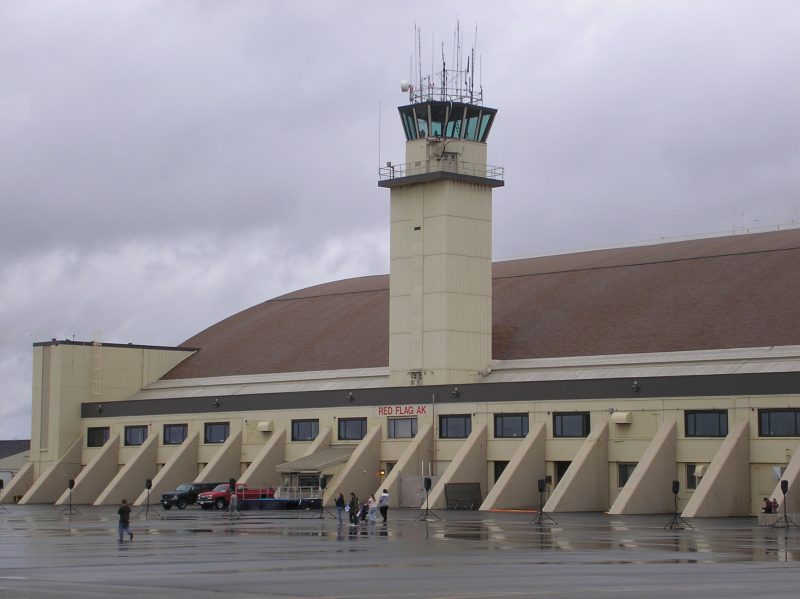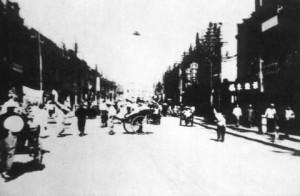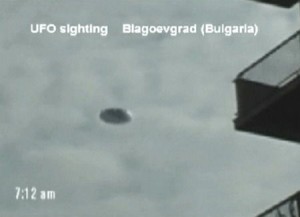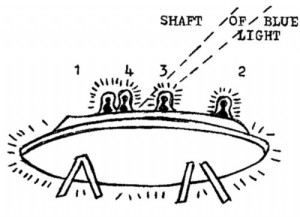Warning: strlen() expects parameter 1 to be string, array given in /home2/orbman69/public_html/wp-includes/functions.php on line 262
(Last Updated On: )
People have been seeing unidentified flying objects in the skies for years. But when the eyewitness is up there with the UFO, is the sighting more difficult to explain?
By Dennis Stacy for Air & Space Magazine December 1987/January 1988
In the late afternoon of November 17, 1986, Japan Air Lines flight 1628, (1) a Boeing 747 with a crew of three, was nearing the end of a trip from Iceland to Anchorage, Alaska. The jet, carrying a cargo of French wine, was flying at 35,000 feet through darkening skies, a red glow from the setting sun lighting one horizon and a full moon rising above the other. A little after six p.m., pilot Kenju Terauchi noticed white and yellow lights ahead, below, and to the left of his airplane. He could see no details in the darkness and assumed the lights were those of military aircraft. But they continued to pace the 747, prompting first officer Takanori Tamefuji to radio Anchorage air traffic control and ask if there were other aircraft nearby. Both Anchorage and a nearby military radar station announced they were picking up weak signals from the 747’s vicinity. Terauchi switched on the digital color cockpit weather radar, which is designed to detect weather systems, not other aircraft. His radar screen displayed a green target, a color usually associated with light rain, not the red he would have expected from a reflective solid object.
Because he was sitting in the left-hand seat, Terauchi had the only unobstructed view when the lights, still in front of and below the airplane, began moving erratically, “like two bear cubs playing with each other,” as the pilot later wrote in a statement for the Federal Aviation Administration. After several minutes, the lights suddenly darted in front of the 747, “shooting off lights” that lit the cockpit with a warm glow.
As the airplane passed over Eielson Air Force Base, near Fairbanks, the captain said he noticed, looming behind his airplane, the dark silhouette of a gigantic “mothership” larger than two aircraft carriers. He asked air traffic control for permission to take his airplane around in a complete circle and then descend to 31,000 feet. Terauchi said his shadower followed him through both maneuvers.
A United Airlines flight and a military C-130 were both in the area and Anchorage asked the airplanes to change course, intercept the Japanese 747, and confirm the sighting. Both airplanes flew close enough to see JAL 1628’s navigation lights, alone in the night sky, before Terauchi reported that the unidentified flying objects had disappeared. The encounter had lasted nearly 50 minutes.
Because it involved an airline pilot and an unidentified flying object that had apparently been captured on radar, the JAL 1628 encounter attracted a great deal of public attention. But UFO reports from pilots – private, military and airline – are not new to the subject of “ufology.” One of the best-known cases was a sighting by Idaho businessman and private pilot Kenneth Arnold. Flying his single-engine airplane over Washington’s Cascade Mountains on June 24, 1947, Arnold spotted nine silvery, crescent-shaped objects skimming along at high speed near Mt. Rainier. They dipped as they flew,” like a saucer would if you skipped it across the water,” Arnold told reporters – and thus “flying saucers” entered the popular vocabulary.
Pilots had reported similar unexplained aerial phenomena before, mainly in the form of the “Foo Fighters” (2) noted by American bomber crews over Europe in World War II. But Arnold’s sighting, with its accompanying front-page publicity, struck a jittery, post-Hiroshima nerve in American society and set off a barrage of similar reports. Skeptics believed that every sighting had a prosaic explanation, such as misidentification of stars, planets, or natural atmospheric phenomena. Others thought that there was more to UFOs, that they could even be visitors from other planets.
Following the Arnold incident, the Air Force was given the responsibility of investigating UFO reports from the United States, first as Project Sign (also called Saucer), then Grudge, and finally Blue Book. Usually understaffed and underfunded, the Air Force program functioned more like a public relations office than a scientific investigation, according to the late astronomer J. Allen Hynek. Hynek himself, who served as a consultant to Project Blue Book from 1948 until it was dissolved in December 1969, gradually changed from a skeptic into a believer.
Not even skeptics can deny the subject’s popular appeal. Last March, a Gallup poll found that 88 percent of its respondents had heard of UFOs. Nearly half of those polled believed UFOs were real, not figments of the imagination or misperceived natural phenomena. Nine percent of the adult population claimed to have seen one.
Of these claims, pilot reports are the ones that interest Richard F. Haines, (3) a perceptual psychologist who compiles AIRCAT, a computerized catalog that lists more than 3,000 UFO sightings by aviators over the past 40 years. Chief of the Space Human Factors Office at NASA Ames Research Center in California Haines is the author of “Observing UFOs”, a handbook of methodology for accurate observation, and the editor of “UFO Phenomena and the Behavioral Scientist”, a collection of psychologically oriented essays on the subject.
——————————————————————————–
AIRCAT’s cases include Blue Book’s declassified files as well as some Haines collected and research personally. Before joining the Space Human Factors Office, his research included interviewing pilots about what they had seen peripherally during takeoffs and landings, data that may one day lead to a redesign of airplane cockpits. “I was interviewing pilot anyway,” he says, “and fell naturally into the habit of asking them if they’d ever seen anything strange.”
Haines concentrated on pilot reports for reasons other than convenience. “They have a unique vantage point simply by being in the air,” he says, “if, for no other reason than if the phenomenon is between your eyes and the ground, you can calculate the slant range, and you’re establishing an absolute maximum distance the object could be away. You can’t do that with the object against the sky background.”
“Pilots also have available to them a variety of electromagnetic sensors of various kinds on board the aircraft itself, which can possibly record some manifestations of the phenomenon, such as electromagnetic frequency and even energy content. They can control the location of their plane so that they can maneuver to gain the best vantage point, under some conditions.” “Finally,” says Haines, “they represent a very stable personality type with a high degree of training, motivation, and selection. If a pilot comes forward with a strange tale, I give him a lot of careful concentration because he’s putting his reputation on the line and maybe his job. He’s had to have thought the details out in his mind already, and perhaps eliminated a number of explanations before going public.”
He’s also likely to request anonymity. Kenneth Arnold, tired of the publicity following his sighting, later commented, “If I ever see again a phenomenon of that sort, even if it’s a 10-story building, I won’t say a word about it.” The feeling was echoed even in the Air Force. When Blue Book’s predecessor, Project Grudge, conducted an informal survey of Air Force pilots in the late 1940s, one respondent said, “If a spaceship was flying wing-tip to wing-tip formation with me, I would not report it.”
One sensational pilot-and-UFO case almost certainly had a prosaic explanation. On the afternoon of January 7, 1948, people near Godman Air Force Base at Fort Knox, Kentucky, reported an object in the sky that looked like “an ice cream cone topped with red.” Captain Thomas F. Mantell, flying in command of a ferry flight of four F-51 Mustangs (P-51s had been redesignated F-51s the previous year), was asked to investigate. None of the fighters were equipped with oxygen, and after three dropped out of the chase Mantell continued alone. “It’s directly ahead and above and still moving at about half my speed,” he radioed. “The thing looks metallic and of tremendous size. I’m going up to 20,000 feet, and if I’m no closer I’ll abandon the chase.” A few minutes later Mantell’s airplane crashed, earning him the dubious distinction as the world’s first “UFO martyr.” (4)
Project Blue Book proposed that Mantell succumbed to hypoxia, or oxygen starvation, and crashed while chasing the planet Venus, but later evidence indicates he was pursuing a top-secret, high-atmosphere Skyhook balloon. The balloons, designed for upper-atmosphere research, were later used by the CIA for surveillance. At altitudes of 70,000 feet or more, the translucent plastic balloons would often be swept rapidly along by the jet stream. Mantell wasn’t the last pilot to die while pursuing, or being pursued by, an alleged UFO. At 6:19 p.m. on Saturday, October 21, 1978, Frederick Valentich of Melbourne, Australia, took off from Moorabbin Airport aboard a rented Cessna 182 bound for nearby King Island. He planned to pick up a load of crayfish for his fellow officers at the Air Training Corps, where he was a flight instructor. An experienced daytime pilot with an unrestricted license and instrument rating, Valentich, 20, was relatively inexperienced at night flying. He was also a UFO enthusiast who, his father said later, had claimed a UFO sighting 10 months before his disappearance.
Out of Melbourne, Valentich paralleled Cape Otway before heading over open water for King Island, where he was scheduled to land at 7:28. At 7:06 he radioed Melbourne Flight Service, asking, “Is there any known traffic in my area below 5,000 feet? Seems to be a large aircraft.” Ground control asked what kind. “I cannot confirm,” Valentich replied. “It has four bright lights that appear to be landing lights…[and] has just passed over me about 1,000 feet above… at the speed it’s traveling is there any RAAF [Royal Australian Air Force] aircraft in the vicinity?”
“Negative,” answered Melbourne. “Confirm you cannot identify aircraft?” Valentich replied in the affirmative, adding three minutes later, “It’s not an aircraft, it’s …” At that point, there was a brief break in the recorded transmission that was later released to the Australian press. “It is flying past,” Valentich continued. “It has a long shape. Cannot identify more than that… coming for me now. It seems to be stationary. I’m orbiting and the thing is orbiting on top of me. It has a green light and sort of metallic light on the outside.” The pilot then informed air traffic controllers that the object had vanished. At 7:12 he was back on the air, reporting his “engine is rough-idling and coughing.” Ground control asked what his intentions were; Valentich said, “Proceeding King Island. Unknown aircraft now hovering on top of me.” His radio transmission ended in a jarring 17-second metallic noise. Neither pilot nor airplane has been seen or heard from since. Some have attempted to explain away the incident as a hoax or a suicide, while others have suggested that the inexperienced night pilot, overcome by vertigo, may have turned upside down and seen the reflections of his own lights before the engine of his Cessna failed. Haines has published a book about the Valentich incident, “Melbourne Episode: Case Study of a Missing Pilot,” and he is in the midst of another compiling all of AIRCAT’s cases. Most are variations on ufology’s two major themes: daylight disks and nocturnal lights. The first involves what appears to be objects in the shape of disks, spheres, or elliptical forms. Nocturnal lights normally appear as single, continuously visible white light sources. Sometimes the lights are also detected by ground or airborne radar and less frequently, accompanied by radio static and brief engine interruption, such as that experienced by Valentich. Most sightings involve two or more witnesses and last slightly more than five minutes, long enough in most cases, says Haines, to eliminate a number of explanations, such as meteors and balloons.
One case from the AIRCAT files involved a pilot – call him Captain Gray – who had logged more than 21,000 hours in a 31-year career. On July 4, 1981, he was piloting a passenger flight in a Lockheed L-1011 Tristar, cruising on automatic pilot at 37,000 feet. The flight was bound from San Francisco to New York’s Kennedy Airport, approaching the eastern shore of Lake Michigan. The lake below was obscured by clouds, but ahead and above the sky was clear. Suddenly, from ahead and to the left of the aircraft, a silvery disk “splashed in to view full size…like the atmosphere opened up,” Gray said later. He leaned forward, blurting out, “What’s that?” Appearing at first like a sombrero viewed from the top, the object rolled as it approached the airplane along an arc that carried it toward and then abruptly away from the L-1011. From the side, the disk appeared ten times wider than it was thick, with six evenly spaced, jet black portholes along its edge. A bright splash of sunlight flared off the top left end of the object. As it disappeared, seemingly in a shallow climb, Gray noticed what looked like the dark smudge of a contrail. “Did you just see anything?” Gray asked his first officer. “Yes,” he replied, “a very bright light flashes.” The flight engineer, his view blocked, had seen nothing.
The overriding question for ufologists is whether a sighting like Captain Gray’s is a natural phenomenon or an object that displays evidence of intelligence. “As a scientist, I have to be cautious,” says Haines. “But when AIRCAT is made public, I think the technical-minded can read between the lines.”
Haines retorts that Captain Gray was a skeptic before his own UFO confrontation. But afterward, “there was no doubt in his mind whatsoever’ that what he had seen was an extraterrestrial spacecraft. Captain Terauchi of JAL flight 1628 was equally convinced that he had encountered an extraterrestrial craft in the skies above Alaska. Skeptics are not so sure, citing the fact that Terauchi had reported seeing UFOs on two previous occasions – and would report yet another sighting the following January, again over Alaska. (He would later explain his second Alaskan encounter as city lights reflecting off ice crystals in the clouds.) That pilots, as well as ground observers, have seen something in the skies is undeniable. The question of what they have seen has yet to be satisfactorily resolved. Maybe it never will be. It may even be irrelevant. As Jacques Vallée, who has written several books on the subject, once said, “It no longer matters whether UFOs are real or not, because people BEHAVE as if they were, anyway.”




Related Reports
Warning: strlen() expects parameter 1 to be string, array given in /home2/orbman69/public_html/wp-includes/functions.php on line 262
7 min read
1955: Radar-Visual Sightings, June 1-8: Article
Warning: strlen() expects parameter 1 to be string, array given in /home2/orbman69/public_html/wp-includes/functions.php on line 262
9 min read
1994: UFO Sighting of Flight AF-3532
Warning: strlen() expects parameter 1 to be string, array given in /home2/orbman69/public_html/wp-includes/functions.php on line 262
10 min read
1995: The American West UFO Sighting – Article